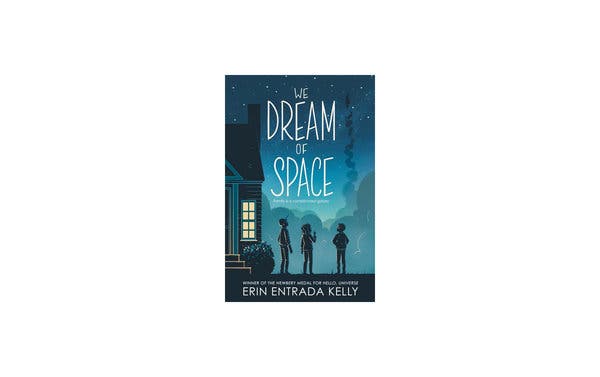It’s January 1986. What do you do if you’re a 12-year-old girl who feels invisible and longs to be a space shuttle commander? In Erin Entrada Kelly’s WE DREAM OF SPACE (Greenwillow, 400 pp., $16.99; ages 8 to 12), Bernadatte Nelson Thomas (known as Bird) daydreams she’s reaching out to Judith Resnik, an astronaut prepping for the launch of the Challenger. An imaginary Resnik talks back, telling Bird, “You’re not disappearing,” and describes being in space as “floating in a world that belongs only to you, but also belongs to everyone else.”
Bird’s sense of being out of sync begins at home. Her squabbling parents and disaffected brothers circle one another like “planets in orbit. No, not planets. More like meteors or space junk.” In this captivating follow-up to her Newbery Medal-winning “Hello, Universe,” Kelly makes lively use of space metaphors to describe dysfunctional family life. The pretend conversations between Bird and Resnik form the tender heart of the novel.
Bird learns of Resnik through her space-obsessed seventh-grade science teacher, Ms. Salonga. When Salonga fails to win NASA’s first-teacher-in-space competition, she channels her energy into her students, declaring January “Space Month!” and dividing them into shuttle teams.
The launch is less of a lure for Bird’s brothers, Fitch and Cash, whose perspectives are interwoven with Bird’s. Fitch, her twin, would rather play Major Havoc, a space-themed video game, at the local arcade. Their older brother, Cash, having failed seventh grade, suffers the humiliation of being in the same grade as his younger siblings and fears being stuck in the void of middle school forever.
Young readers won’t share the premonition of their parents, perhaps old enough to remember searing images of the Challenger’s explosion moments after liftoff, as schoolchildren across the country were gathered to watch. The real first-teacher-in-space, Christa McAuliffe, died, along with the rest of the crew.
Kelly keeps the disaster offstage, fixing on Bird’s shock. And in the solar system of seventh-grade life, closer encounters can loom as large as public catastrophes. Dropped from the school basketball team because he can run but not jump, Cash searches for a talent that will tug away his enduring sense of failure. After an in-class outburst at a girl who’s done nothing more than have an unwanted crush on him, Fitch must figure out how to make amends.
Bird, too, grapples with quandaries that translate across eras: Does she like or like-like Devonte, the boy who sits next to her, the novel’s one overtly racialized character? How can she get her wonkily orbiting family to sit down to dinner together when she can’t even clear a stack of magazines from the dining room table without her mother complaining?
Kelly has a minimalist’s knack for gesturing beyond what’s on the page. She paints a gimlet-eyed yet nonjudgmental portrait of the Nelson-Thomas parents, who toss thoughtless barbs at their children, the kind that wound. “Grown-ups are such hypocrites,” Fitch notes.
“We Dream of Space” moves gracefully between small-scale middle school dilemmas and galaxy-size existential questions, such as whether we should go into space at all. Bird, “just a girl in Park, Delaware,” can’t stop thinking about being a speck of cosmic dust. Thanks to exuberant Ms. Salonga, there’s lots of space lore in the novel. Notably, the characters most interested in science are female.
Today’s children have their own keen sense of how the world can be thrown wrenchingly off-kilter by forces beyond their control. These last months they’ve experienced living like astronauts in cramped lockdown quarters while the world floats past outside. In the absence of parental guidance, sometimes the young must come together and look after one another, as Bird and her brothers attempt to do. It’s a hard-won, timeless lesson.





